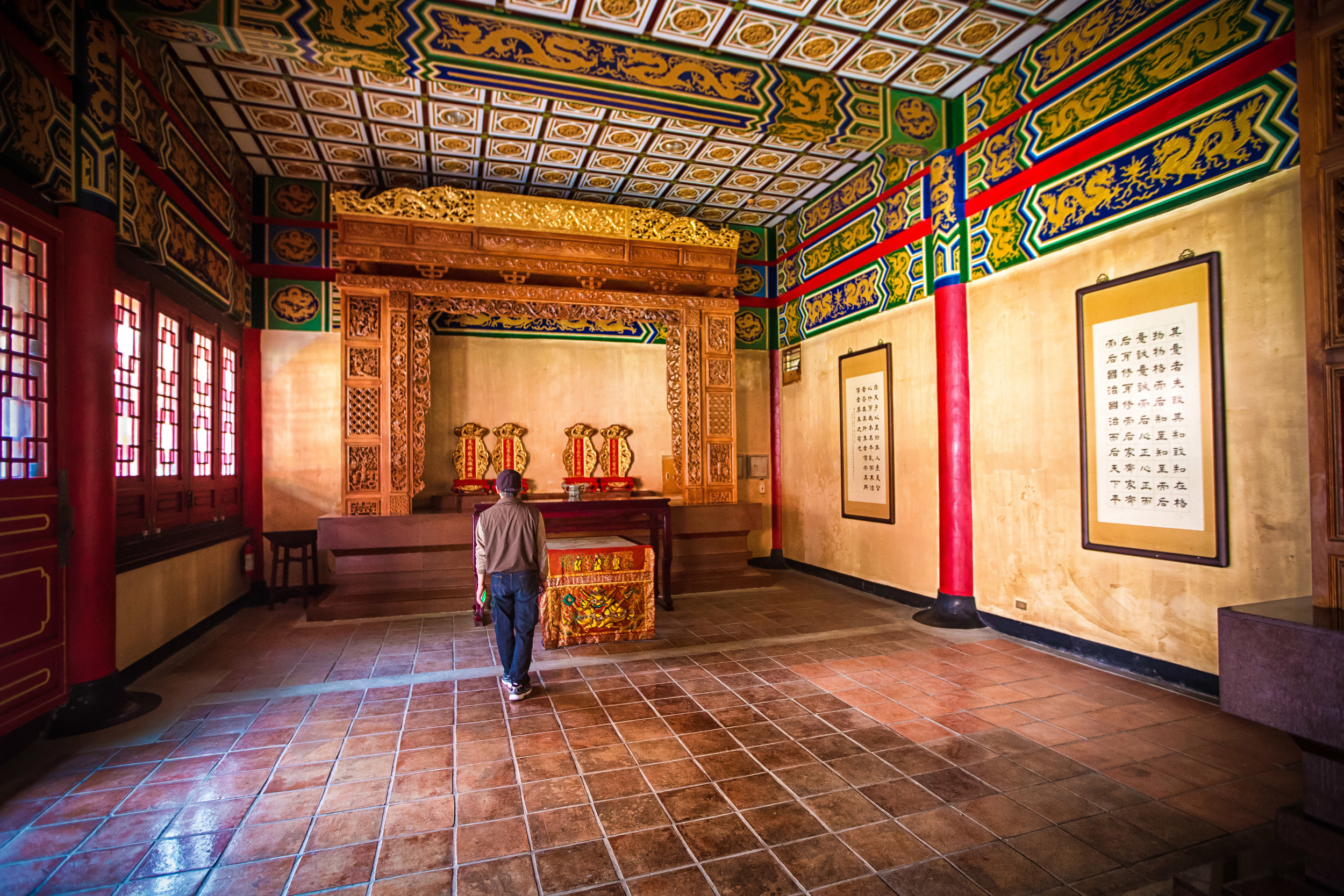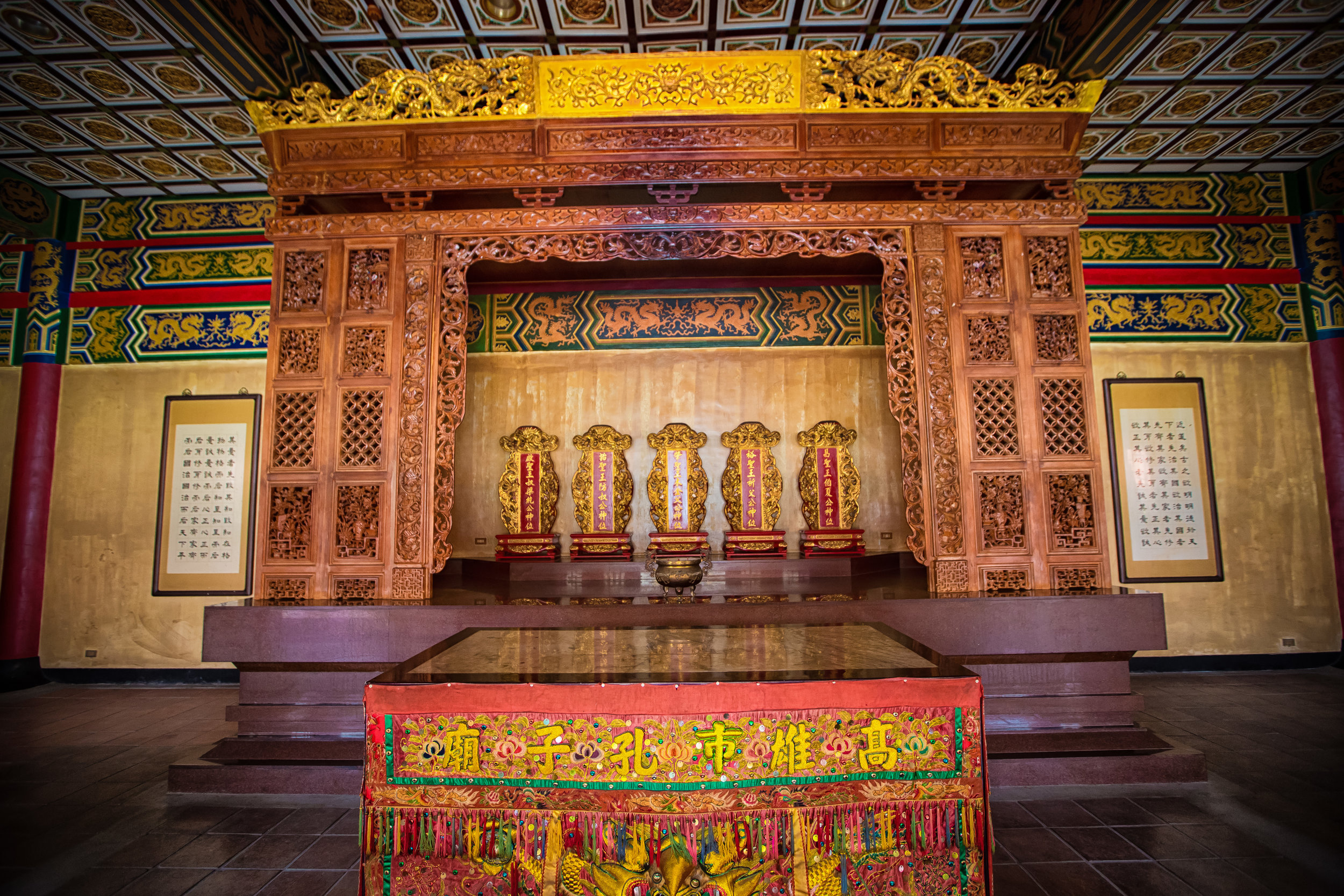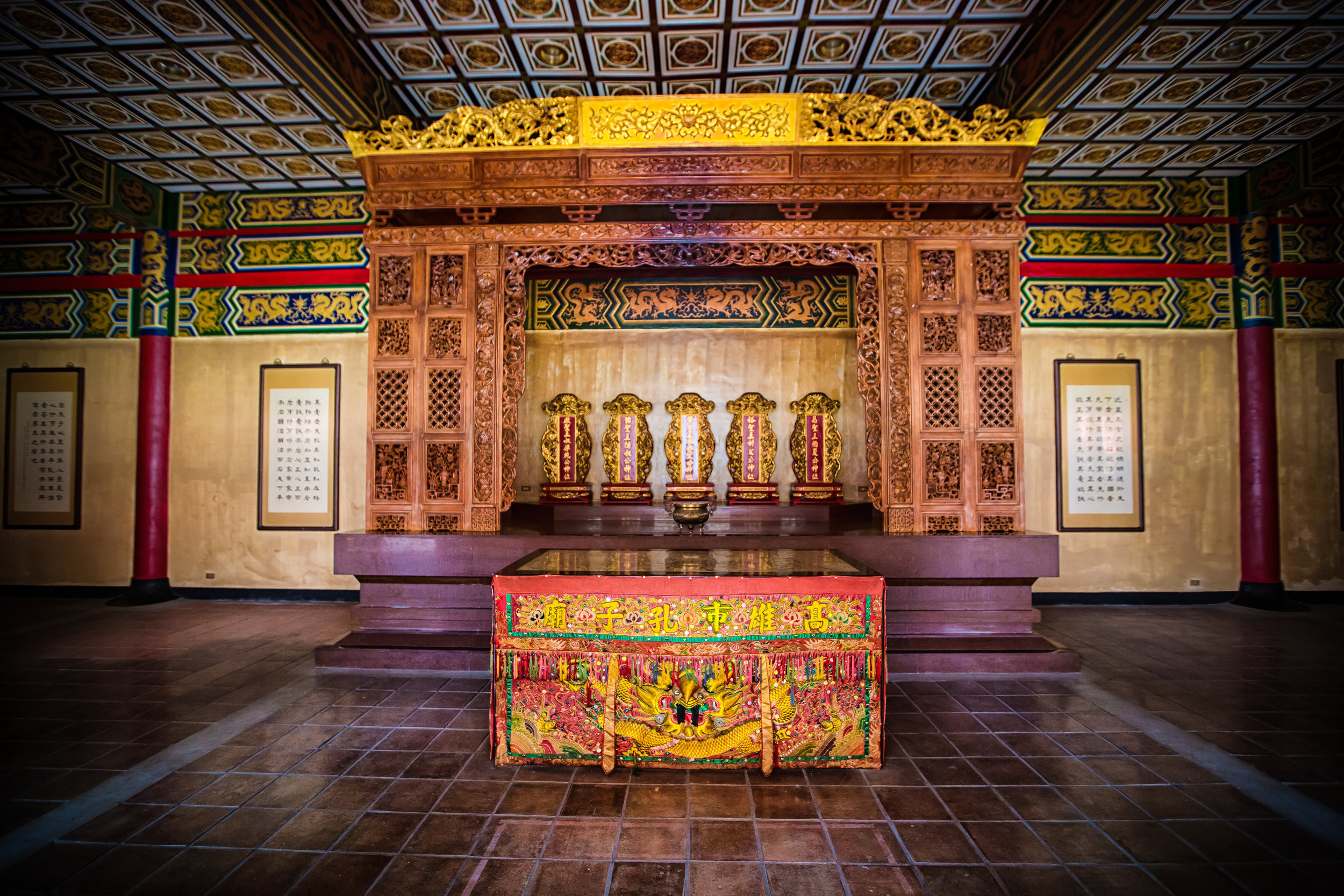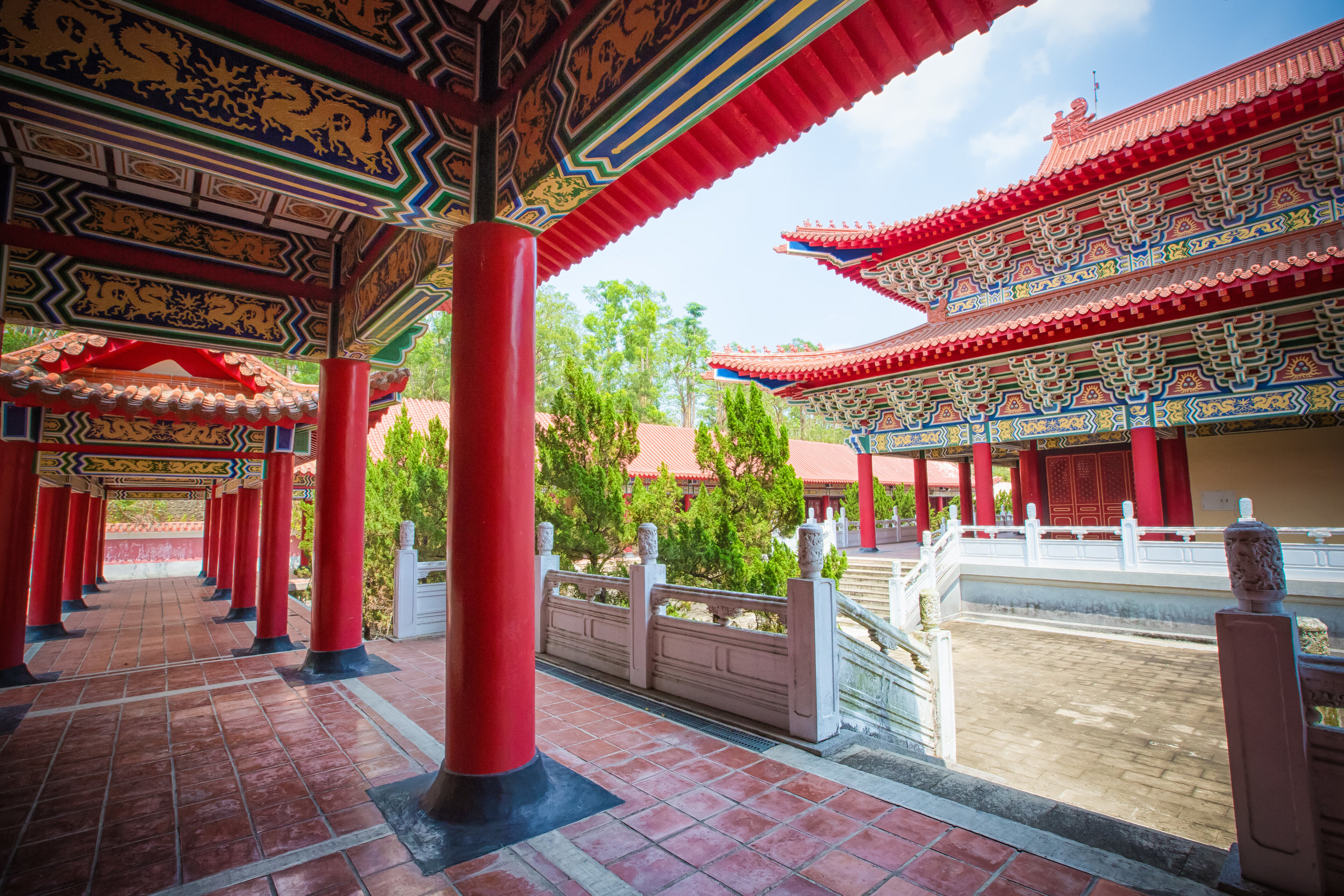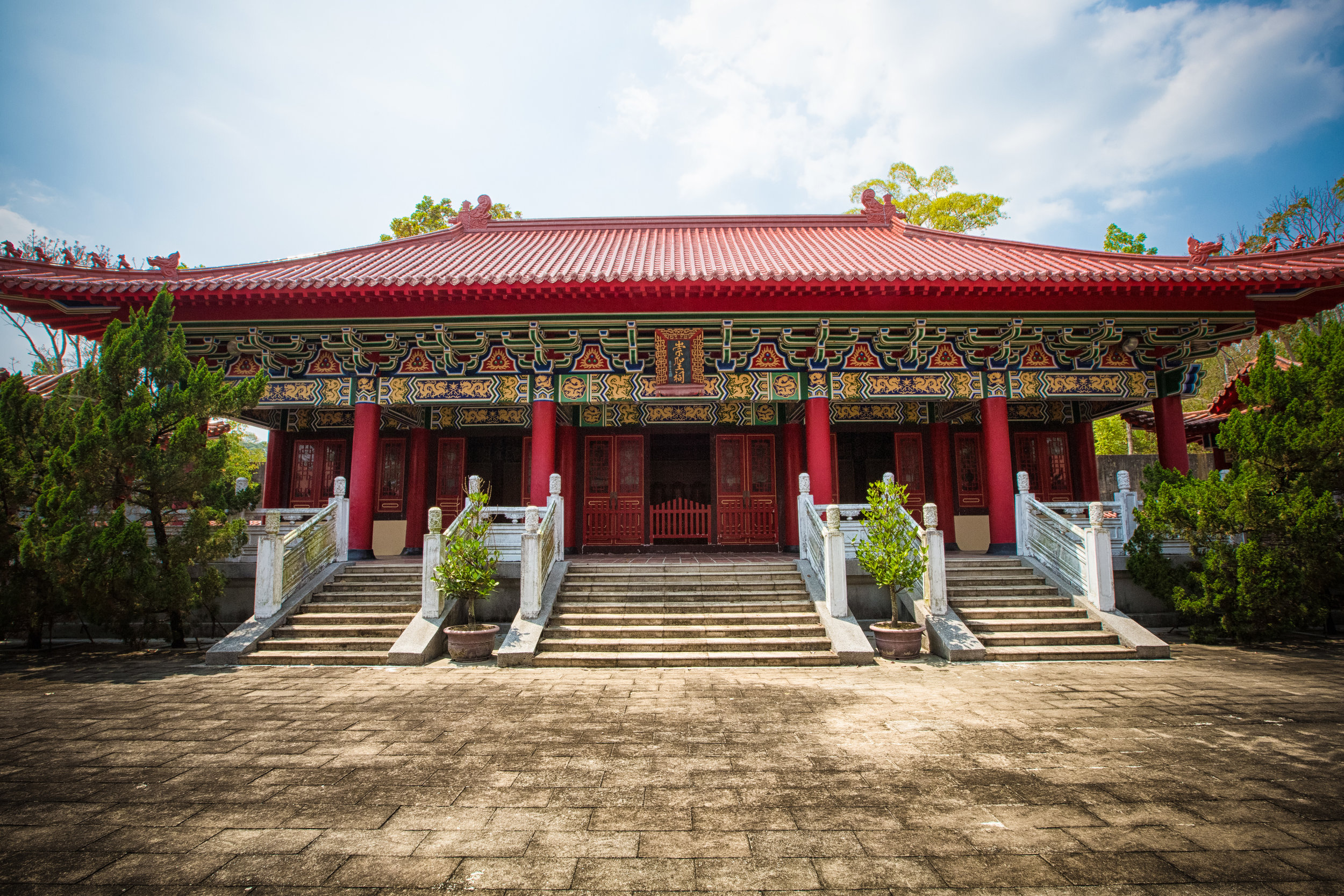I've spent quite a bit of time so far this year travelling up and down the country working on my Martial Arts Hall project having already visited the majority of the remaining halls but still missing out on the halls that are the furthest south. I remedied that however with a well executed trip to Kaohsiung that not only included a trip to the Kaohsiung city Martial Arts Hall but also to the Qishan Hall which is an hour or so long bus ride outside of the city.
While planning for the trip I spent a bit of time mapping out my route on Google maps. I needed to know the quickest possible walking or bicycling route from the Qishan bus station to the Martial Arts Hall in order to utilize the time I had in the best way possible.
When I was looking at the Martial Arts Hall on satellite view I noticed something interesting on a mountain beside it. It seemed like there was a huge temple up there. I zoomed in and the title "Kaohsiung Confucius Temple" popped up. I did a quick search on google to find out what it was and when I saw the description: "The largest Confucius Temple in South East Asia" I automatically decided to add the temple to my itinerary.
I have become a bit of a pro when it comes to taking photos of Confucius Temples - This isn't to say that my photos of the temples are particularly interesting or even look good but I have a lot of experience with them and since they are mostly uniform in design I figured that even though this was dubbed as the largest Confucius Temple in Taiwan and also South East Asia that I could swoop in and out and get the shots I needed without spending much time.
I have to admit, I was wrong. There was no way I would have been able to just walk into this temple, take a few photos and leave. It was simply just too big and too impressive to not spend a little extra time to enjoy the minor details.
So far I've written about a few of Taiwan's other Confucius Temples which include the historic Tainan Temple as well as the Taipei, Taoyuan and Hsinchu temples. There are however over twenty large Confucius Temples Taiwan and are typically constructed at the city or county level and vary in age from over three centuries to less than three decades.
History
The Kaohsiung Confucius Temple, not to be confused with that other "Kaohsiung Confucius Temple" is one of three Confucius Temples in the greater Kaohsiung area which all happen to more or less have the same English name.
For clarity sake I think its probably better to refer to this specific temple as the "Kaohsiung County Confucius Temple" (高雄縣孔廟) or the "Qishan Confucius Temple" (旗山孔廟). But in the case of "Kaohsiung County" it becomes confusing as the "county" ceased to exist a few years ago when the county and the city amalgamated into the area known as "Greater Kaohsiung" (大高雄市).
If I was talking to a Taiwanese person, they would of course understand that the Kaohsiung County Confucius Temple was the one in Qishan, but when it comes to English it becomes a bit confusing and is likely one of the reasons why there is so little English information available when it comes to this specific Confucius Temple.
The Kaohsiung Confucius Temple is not particularly an old temple, but there is a long history on the ground for which it stands. The temple is situated within Zhongshan Park (中山公園) and has an area of 41,169 square meters. While the temple may be lacking in history, it is certainly not lacking in size and easily makes the other Confucius Temples in Taiwan look pretty small in comparison.
The temple was built on the site of the Qishan Shinto Shrine (旗山神社/きざんじんじゃ) which was built in 1936 (昭和8年) and served its purpose until the Second World War when it was partially destroyed and left to rot. In 1983 a local politician promoted the demolition of what was the original shrine and planned for a Confucius Temple to be constructed in its place.
Construction on the temple started in 1984 and surprisingly was completed only a year later opening to the public in time for the annual Teachers Day celebrations. Unfortunately it seems that when it was built, in order to complete the temple as fast as possible a few short cuts were taken which forced the temple to close in 1993 for a period of eight years to reconstruct and repair some of the damaged buildings caused by a weak foundation, erosion and earthquakes.
The temple reopened to the public in 2001 (民國90年) and since 2004 the annual Teacher's Day celebrations on the anniversary of Confucius's Birthday are held on a grand scale at the temple.
Design
Confucius temples tend to be uniform in their simplicity - Unlike the overwhelming beauty of Taiwanese folk temples and Taoist temples - Confucius temples stand alone in their almost "zen-like" nature in that they don't have shiny gold or bronze decorations and murals all over the walls with hundreds of sticks of incense creating a haze throughout the temple.
The simplicity exhibited in Confucius temples throughout China, Hong Kong and Taiwan is meant to be a show of respect to Confucius as well as the importance of his philosophical views of education and his influence on Chinese culture and history.
One of the common features of all Confucius temples is that there is no imagery or statues of Confucius. This is a rule that goes back almost 500 years to the Ming Dynasty (明朝) when the emperor decreed that all Confucius temples should be uniform and only have "spirit tablets" (神位) rather than images of the sage. This practice has endured in Confucius temples up until today.
Below I'm going to describe a bit of the key features and different buildings within the Confucius Temple:
Dacheng Hall (大成殿)
Dacheng Hall is the main shrine area of any Confucius temple. The hall, which is known in English as the "Hall of Great Achievement" sits in the architectural centre of the entire complex and is also in the middle of a large granite courtyard. Inside the hall is a very simple set up with the Confucius spirit tablet set up on a nicely decorated table.
Suffice to say that with the rest of the complex being as large as it is, the Dacheng Hall at this temple, which is the main attraction is equally as large. When you walk into the main hall you can't help but feel a bit of awe at the sheer size of the single-room hall. The ceiling is quite high and when you walk in you might feel a bit like an ant.
On either side of the Confucius shrine there are additional shrines dedicated to the four sages (四配) Yan Hui (顏子), Zengzi (曾子), Zisi (子思) and Mencius (孟子) who were Confucius scholars and authored books which expanded upon the Confucian philosophy and has had a lasting impact on Chinese culture and the diaspora of Chinese people's throughout the world.
The building is the highest building within the main complex and is elevated off the ground. In the front of the hall is a stone carved mural of a dragon with several more dragons on the roof. In the middle of the roof there is a 'seven-levelled' pagoda which is thought to suppress evil.
Chongsheng Shrine (崇聖祠)
The Chongsheng Shrine is traditionally situated behind the main Dacheng Hall and is used as a shrine room to venerate the ancestors of Confucius as well as the various Confucian sages and philosophers throughout history. This shrine room is not unlike a shrine room that you'd find in any large Taiwanese home and is an important place for ancestral worship for the descendants of Confucius whom have over time spread out throughout the world.
The Chongsheng Shrine in this temple is accessible to the public and has several different shrines with spirit plates for the many different generations of Confucius's ancestors. The room isn't as grand as some of the other areas of the temple but it is quiet and there's a nice breeze through the pills on the exterior.
The Kaohsiung Confucius Temple has the honour of being the largest in all of Taiwan but at the same time also one of the loneliness of them all. I visited the temple on a weekend and apart from a young couple who were hanging out at the main doors making out, I was the only person inside the whole complex.
The relative emptiness of the temple was great for a few reasons - The first that I didn't have to worry about people ending up ruining my shots. The second is that the temple is supposed to be a place where people go to be educated, relax and contemplate the larger aspects of life. I feel like in the case of this Confucius Temple, it would be much easier to sit next to one of the massive pillars, enjoy the mountain air and the peace and quiet of the temple.
I suppose the reason for the relative emptiness of the temple can be attributed to a number of factors - The first being that most people don't actually have any idea that it is there. The next is that most tourists prefer to take leisurely walks through the old street rather than walking up the steep set of stairs that brings you to the temple.
No matter what the reason, I think more people should know about the Kaohsiung Confucius Temple - Even though its not one of the older temples, its certainly the biggest and also the most peaceful. If you are in the Qishan area, make sure to stop by and check it out!
Map / Location
For more information about Taiwan’s Confucius Temple’s please check out my Confucius Temple Guide.






